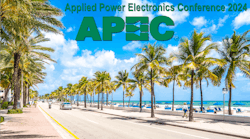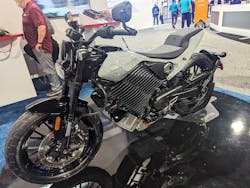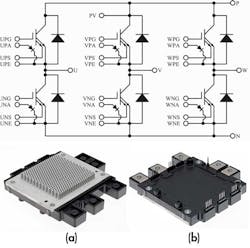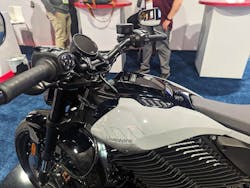Rugged SiC Power Module Drives HD's “Sexiest” eBike
What you’ll learn:
- LiveWire, a spinoff company from Harley-Davidson, introduced an electric motorcycle that combines many of the virtues of HD's venerable V-twin Sportster with modern technology and impressive all-electric performance.
- The LiveWire Del Mar 2 is powered by an 84-hp brushless DC motor that moves the bike from 0 to 60 mph in three seconds.
- The cycle's asphalt-burning amperes are delivered to its motor via an electronic traction inverter, based on Mitsubishi's CT600CJ1A060-A power module that uses SiC transistors.
Mitsubishi Electric's power devices team had no problems attracting visitors to its booth at the IEEE's 2024 APEC power technology conference, thanks to the stunning LiveWire electric motorcycle that the company had on display.
In addition to doing a much better job at generating foot traffic than the squishie balls, pens, or other traditional booth swag, the Del Mar S2 sports bike served as a dramatic example of how Mitsubishi's J1 series of SiC power modules can be used to provide robust, efficient traction power to electric vehicles (EVs) and hybrid EVs (HEVs), regardless of how many wheels they have (Fig. 1).
Del Mar eBike: Functional and Stylish
Conceived as a more agile, affordable (and attractive) successor to the LiveWire One, the Del Mar series combines smart, functional design with a style that blends the rugged features of Harley-Davidson's legendary V-twin series with an edgy high-tech look. As a result, the Del Mar presents the look and feel of a traditional Harley Sportster sport bike, built to meet the challenges of the 21st century. With a base price of $15,499, it adds up to a fun, practical, and (almost) affordable way to enter the world of electric two-wheeling.
Unlike most Harleys, this bike is designed to perform well on tight, twisty roads, as well as in a straight line. Its modular frame, which features a free-piston Showa mono-shock, massive Brembo brakes, and a low center of gravity, is engineered for excellent handling. And while it won't set any speed records or win the hearts of hardcore V-twin devotees, the Del Mar's 63-kW/84-hp permanent-magnet DC motor (5,000 rpm max) delivers more than enough power to satisfy many serious cyclists.
During our interview (see the video above), Adam Falcsik, Senior Product Manager, Mitsubishi Electric, explained that the cycle's asphalt-burning amperes are delivered to its motor via an electronic traction inverter. It’s based on Mitsubishi's CT600CJ1A060-A, a 650-V, 600-A power module that uses SiC transistors (Fig. 2a).
SiC-Transistor-Based Power Module Drives Inverter
The module is liquid-cooled directly through the package's pin fins for good thermal efficiency and simplicity of construction (Fig. 2b). Thanks to integrated thermal/electrical protection features, LiveWire's design engineers were able to give the go-ahead to drivers looking to exploit some of the extreme regions of its performance envelope (up to 500 A @ 400 V) without risking damage.
For the most part, the Del Mar's specs are as impressive as its looks. It has a 0-to-60-mph time of 3.0 seconds and a top speed that's electronically limited to 103 mph. A quick test sitting indicates that it's surprisingly comfortable for a sports-type bike, with a well-positioned seat complemented by good control ergonomics (so good that I had to work hard to resist the urge to hotwire the bike and take it for a spin).
The DelMar also gives you a comfortable riding position that keeps you tightly coupled to your machine while ensuring that your bike will run out of energy before you do (Fig. 3).
What About the eBike’s Range?
This brings me to my only real quibble with the DelMar 2—its range. The Del Mar's 10.5-kWh battery gives it a "City" range rating of 113 miles, just about enough to make it a fun and practical daily driver or a casual weekend runabout, especially when you consider that its onboard charger can let you "top up" from nearly any 110/220-V outlet while you enjoy the view from your favorite bistro or roadside cantina.
However, its documented "combined" range of 86 miles for intermittent driving at 55 mph, and 70 miles at sustained highway speeds, severely limits its potential for use in the blessedly relaxing 150-to-200-mile day trips I more-than-occasionally enjoy taking.
Despite its many virtues, I fear that the Del Mar's relatively short range may be a deal-killer for a portion of its potential customer base. From first impressions, I like the bike so much that I'm praying that Livewire updates its design to accommodate a range-extending battery pack. The pack could be mounted like a pair of saddlebags, or possibly a cargo box behind the rider and passenger. I'd gladly pay Livewire (or a third-party vendor) handsomely for a solution that added 50% or more to the range of this delightful machine.
For more information on LiveWire's Del Mar 2 electric motorcycle, visit this link. In addition, Mitsubishi posted an interesting video that offers a few additional insights into LiveWire's design, as well as some of the other applications its power module can be used for.




